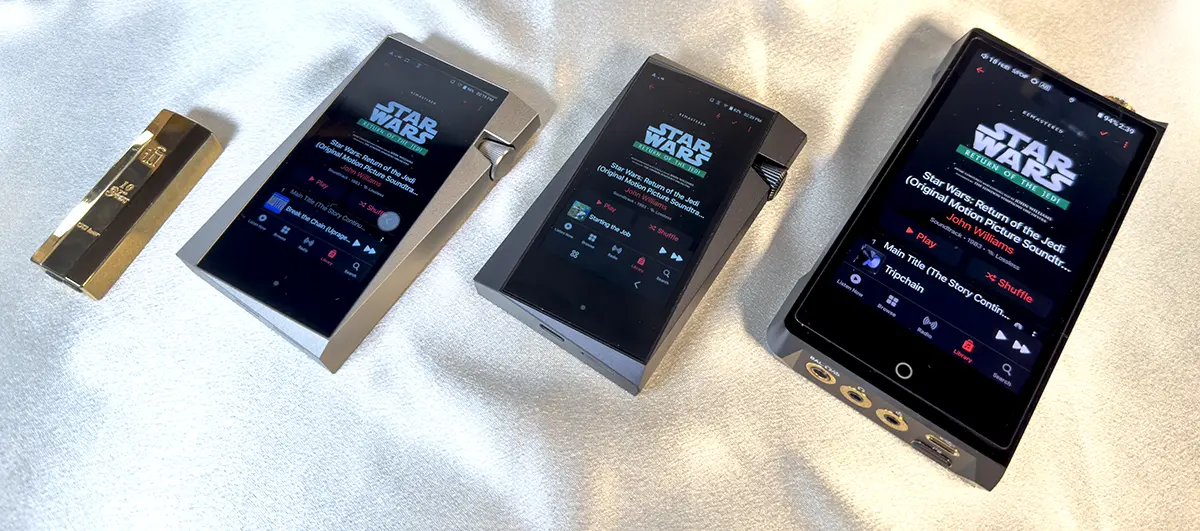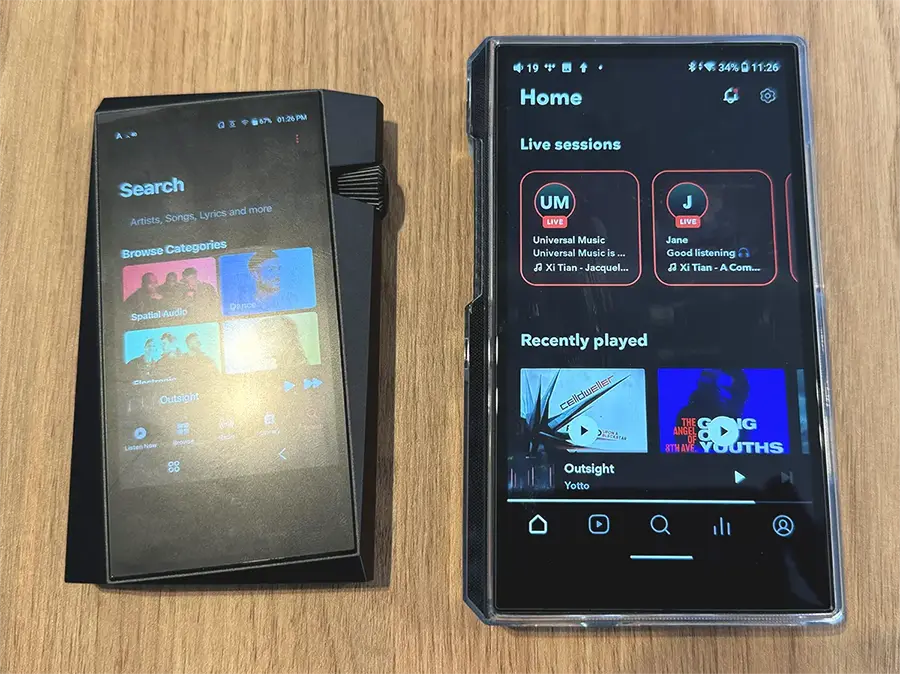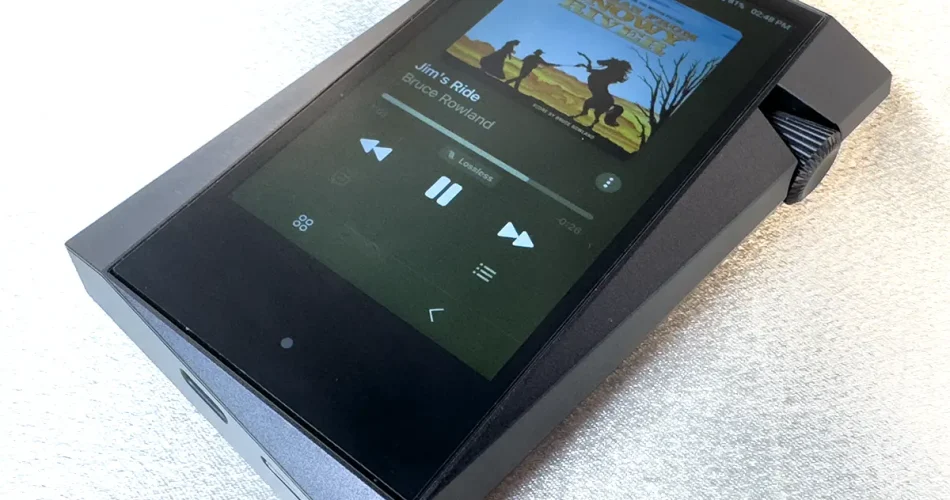Source Comparisons

Astell & Kern SR25 MKI – 178 grams (USD $700)

This is probably the most important comparison if you own the original SR25 and have been eyeing the SR35. Like me you may have been tempted by the SR25 MKII but felt it wasn’t enough of an improvement to warrant upgrading despite the 4.4mm socket being tempting.
The SR35 is a more dramatic step up. Though both players feel almost identical in the hand, the performance gap is significant. The SR35 has superior note weight, much deeper bass impact, better soundstage depth and superior dynamics – those are the improvements that really jump out at you.

More nuanced enhancements are the SR35’s more effortless resolution with trailing echoes of notes easier to pick up, slightly more midrange presence and more sharply defined transients. The SR25’s character is more digital with a flatter, one-note feeling – essentially it sounds like micro DAP, a trait the SR35 defies much more effectively.
In terms of usability, the screen is the same size on both players and ergonomics haven’t changed significantly. I was hoping the SR35 would include a faster CPU but performance feels similar.
iFi Go Bar 10th Anniversary – 64 grams (USD $500)

What’s immediately apparent here is how far dongles need to progress to match the performance of even a small DAP like the SR35.
The Go Bar has a vastly higher noise floor which is plainly evident during quiet passages, its’ stage is smaller across all dimensions but especially in width, note weight is lower and the in general the sound feels mushier and more mechanical with flatter dynamics.
The Go Bar competes surprisingly well when it comes to resolution, yet the trailing off of individual notes are a tad more muted. Instruments are also more poorly defined in space, and have a tendency to blend together particularly during busy passages. I do really enjoy the Go Bar’s tonality, but find it handily outclassed by the SR35 in all other areas.
Cayin N8ii – 442 grams (USD $3499)

The N8ii competes in a different weight division to the SR35, figuratively & literally. Far less comfortable to pick up & hold, but its’ 5″ screen is immensely brighter with superior contrast & colour. The N8ii’s CPU & internal modem also deliver a smooth smartphone-like experience, highlighting the SR35’s deficiencies in those areas.

Sonically the N8ii boasts numerous improvements over the SR35 which tend to be smaller than you’d expect in individual areas, but their net effect adds up to a much more refined sonic experience.
Delivering a pronounced V-shaped sound, the N8ii’s thunderous sub bass is much more impactful than the SR35’s and treble is accentuated more as well, though I do find can be a little bright at times. The N8ii’s other shortcoming is its’ soundstage width – below that of many flagship DAPs and similar to the SR35’s, but the N8ii’s stage is taller and much deeper.
With a blacker background, superior dynamics and more defined imaging & separation, instruments also sound larger on the N8ii with a greater sense of space surrounding them. During A/B tests the SR35 can feel mushier & more congested, and moderately less resolving though I expected the difference in detail retrieval to be larger than it is. Despite its’ V-shape nature the N8ii’s ROHM DACs deliver a richly organic texture, leaving the SR35’s presentation feeling stiffer & more mechanical.

I also paid a visit to Addicted to Audio in Melbourne to compare the SR35 to a few more DAPs from their lineup. Please do bear in mind discerning subtle differences between players is more difficult in this noisier environment so these impressions will be briefer. My Penon Impact IEMs were used for the comparisons, which required a volume level of 40 out of 150 on the SR35, and all DAPs were run in their highest gain mode.
FiiO M11 Plus – 295 grams (USD $600)

This is my first time hearing the M11 Plus, and right off the bat it impresses me far more than its’ asking price suggests – if you’re on a budget and insist on a DAP with a larger screen you can do much worse than this.
Physically the FiiO DAP is quite small but solidly built with the output jacks on the underside of the player. It lacks a volume wheel, instead providing + and – volume buttons. I’m not a fan of this approach, but you may not be bothered by it.
The M11 Plus has a V-shaped presentation reminiscent of the N8ii, delivering far deeper & more prominent bass than the SR35. The M11 Plus’s ESS ES9068AS DAC also features a blacker background, but lacks the SR35 midrange coloration which make vocals feel richer. With the Impacts requiring a volume of only 19/120 it’s clear the M11 Plus has power to burn.
Astell & Kern KANN MAX – 305 grams (USD $1200)

KANN MAXX is another medium sized DAP, and although quite short & narrow is very thick and definitely not light. Like every A&K DAP it feels absurdly solid & well-built, and its’ unusually small & squat form factor is quite comfortable in the hand. With the Impacts requiring just 25/150 volume it’s clear this is a powerhouse not lacking grunt.
Unsurprisingly then KANN MAXX’s sound is characterised by a beefy bottom end, along with fairly prominent treble. However MAXX’s dynamics do not impress me, but resolution is very good. MAXX’s stage is definitely wider than the SR35’s but not much deeper, though I find the SR35 sounds a little mushier overall.
The M11 Plus seems to have superior dynamics, but MAXX feels a bit more refined, resolving & natural than the FiiO player. Unfortunately MAXX strikes me as a half-way house that’s neither small nor cheap enough to be attractive, nor sonically impressive enough unless you absolutely require a beefy built-in amplifier – I haven’t had have the opportunity to test MAXX with headphones but assume it drives them quite well.
Astell & Kern SE300 – 317 grams (USD $1900)

As A&K’s first R2R DAC player SE300 is something of a departure for the brand, and is priced at a not-quite-flagship level.
The usual impeccable A&K build quality is evident as expected, but the Impacts requiring 40/150 volume (same as the SR35) suggests the SE300’s built-in amp may not be as powerful as many flagship players. However I do much prefer the SE300 in hand to the SP3000 which has always felt 100g too heavy for my taste, whereas at 317g the SE300 represents a superb tradeoff between weight & performance.
Like the N8ii, sonically the SE300 is a big step up from the SR35. It’s characterised by a very smooth, organic & refined R2R sound with relaxed treble & terrific bass impact that is very easy to listen to without fatigue, yet delivers all the detail & nuances one could want. Unfortunately the slightly rounded R2R transients probably don’t synergise terribly well with the Impacts’ more restrained treble that can benefit from a bit more excitement, but I’ve been impressed by the SE300 enough to earmark it as a DAP I definitely plan on demoing with other IEMs in future.
Page 1 – Introduction, Tech Specs & Battery Life
Page 2 – Ergonomics & Usability
Page 3 – Sound Performance
Page 4 – Source Comparisons
Page 5 – Conclusion


Comments